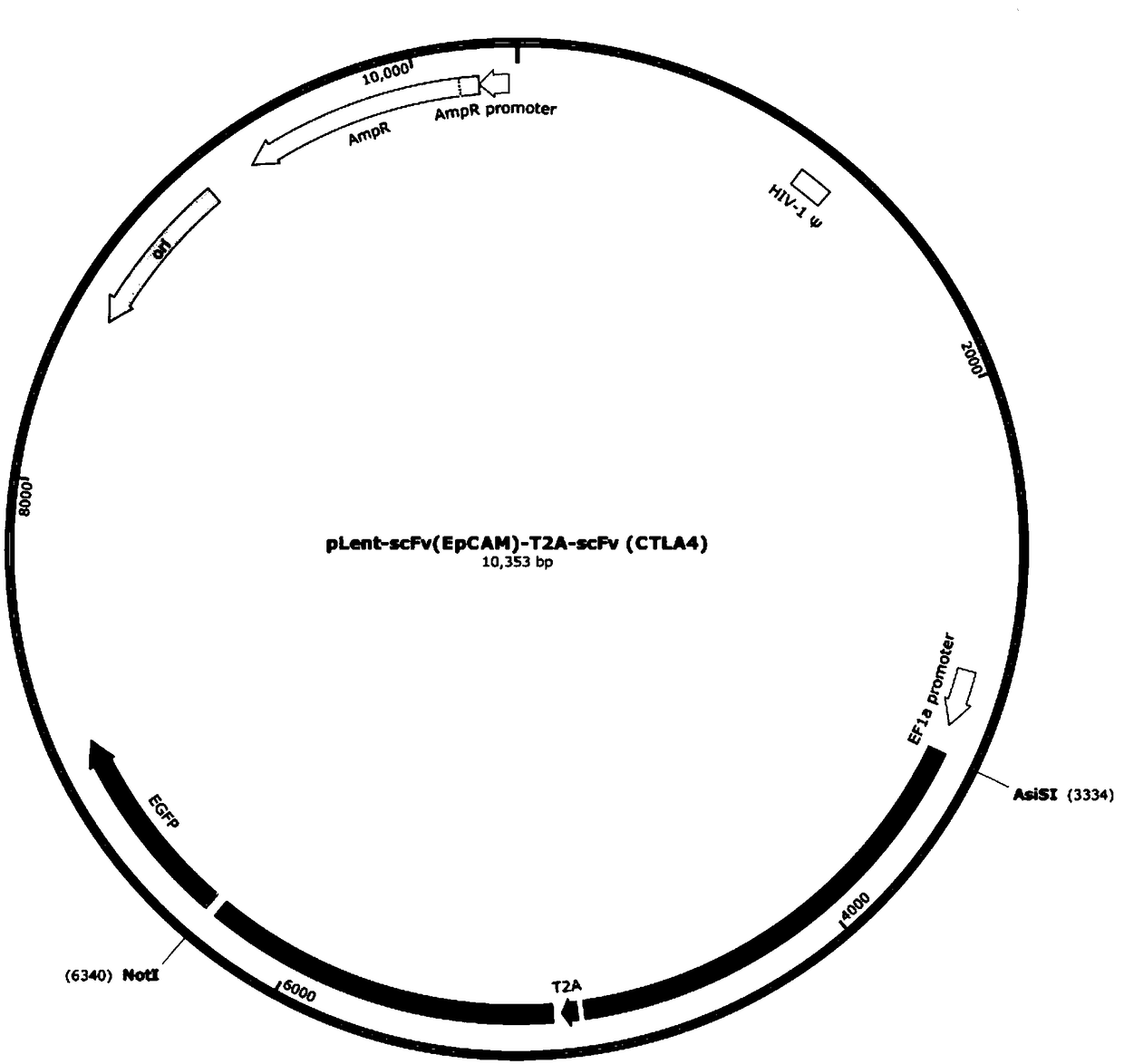Anti-EpCAM chimeric antigen receptor encoding gene, preparation method, plasmid and immune cell with gene and application of encoding gene
A technology of chimeric antigen receptor and coding gene, applied in the field of genes
- Summary
- Abstract
- Description
- Claims
- Application Information
AI Technical Summary
Problems solved by technology
Method used
Image
Examples
Embodiment 1
[0064] The anti-EpCAM chimeric antigen receptor coding gene, wherein at least includes the EpCAM binding region and the CTLA4 binding region, and simultaneously includes the T2A nucleic acid artificial sequence between the two; also includes a transmembrane-stimulatory domain; the said The transmembrane-stimulatory domain is selected from CD8, CD27, CD28, CD226, 4-1BB (CD137), CD134 (OX40), all or partial fragments of ICOS molecules.
[0065] In this embodiment, the transmembrane-stimulatory domain is described by taking CD226 and 4-1BB as examples.
[0066] Such as figure 1As shown, the anti-EpCAM chimeric antigen receptor coding gene of the present embodiment includes the Leader nucleic acid artificial sequence (SEQ ID NO.2) connected in sequence, the EpCAM binding region nucleic acid artificial sequence (SEQ ID NO.3), and the CD8 Hinge region Nucleic acid artificial sequence (SEQ ID NO.5), CD8 transmembrane region nucleic acid artificial sequence (SEQ ID NO.6), CD226 intra...
Embodiment 2
[0068] Example of preparation of anti-EpCAM chimeric antigen receptor coding gene.
[0069] The preparation method of the anti-EpCAM chimeric antigen receptor coding gene of the present embodiment comprises the following steps:
[0070] According to the order of the fusion gene fragment Leader-scFv (EpCAM)-CD8-CD226-4-1BB-CD3ζ-T2A-Leader-scFv (CTLA4)-CD8-CD3ζ, we commissioned Sangon Bioengineering (Shanghai) Co., Ltd. to synthesize the entire expression box, inserted into the T vector pUC57 to obtain pUC57-scFv(EpCAM)-T2A-scFv(CTLA4).
[0071] (2) Carry out double digestion of pUC57-scFv(EpCAM)-T2A-scFv(CTLA4), use agar gel electrophoresis to cut out the agar part containing the scFv(EpCAM)-T2A-scFv(CTLA4) DNA fragment, pass through the sol solution Treat, pass through the DF column and discard the filtrate, rinse the DF column, empty, elute the DF column, collect the centrifuge, and obtain the purified scFv (EpCAM)-T2A-scFv (CTLA4) DNA fragment, which is the anti-EpCAM chime...
Embodiment 3
[0081] Example of a plasmid with an anti-EpCAM chimeric antigen receptor encoding gene.
[0082] The plasmid with the anti-EpCAM chimeric antigen receptor coding gene is prepared by a method comprising the following steps: respectively according to the fusion gene fragment Leader-scFv (EpCAM)-CD8-CD226-4-1BB-CD3ζ-T2A-Leader-scFv ( The sequence of CTLA4)-CD8-CD3ζ was inserted into the NotI-AsiSI site of the pLent-C-GFP carrier, and transformed into E.coli Top10. After identification by bacterial liquid PCR, the plasmid was extracted using a plasmid extraction kit. After the plasmid was sequenced correctly, the The recombinant plasmid with correct sequencing results is named pLent-scFv(EpCAM)-T2A-scFv(CTLA4), such as figure 2 shown.
[0083] In this embodiment, the more detailed steps are:
[0084] Insert the NotI-AsiSI site of the pLent-C-GFP vector in the order of the fusion gene fragment Leader-scFv (EpCAM)-CD8-CD226-4-1BB-CD3ζ-T2A-Leader-scFv (CTLA4)-CD8-CD3ζ respectively...
PUM
| Property | Measurement | Unit |
|---|---|---|
| Titer | aaaaa | aaaaa |
| Titer | aaaaa | aaaaa |
Abstract
Description
Claims
Application Information
 Login to View More
Login to View More - R&D
- Intellectual Property
- Life Sciences
- Materials
- Tech Scout
- Unparalleled Data Quality
- Higher Quality Content
- 60% Fewer Hallucinations
Browse by: Latest US Patents, China's latest patents, Technical Efficacy Thesaurus, Application Domain, Technology Topic, Popular Technical Reports.
© 2025 PatSnap. All rights reserved.Legal|Privacy policy|Modern Slavery Act Transparency Statement|Sitemap|About US| Contact US: help@patsnap.com



